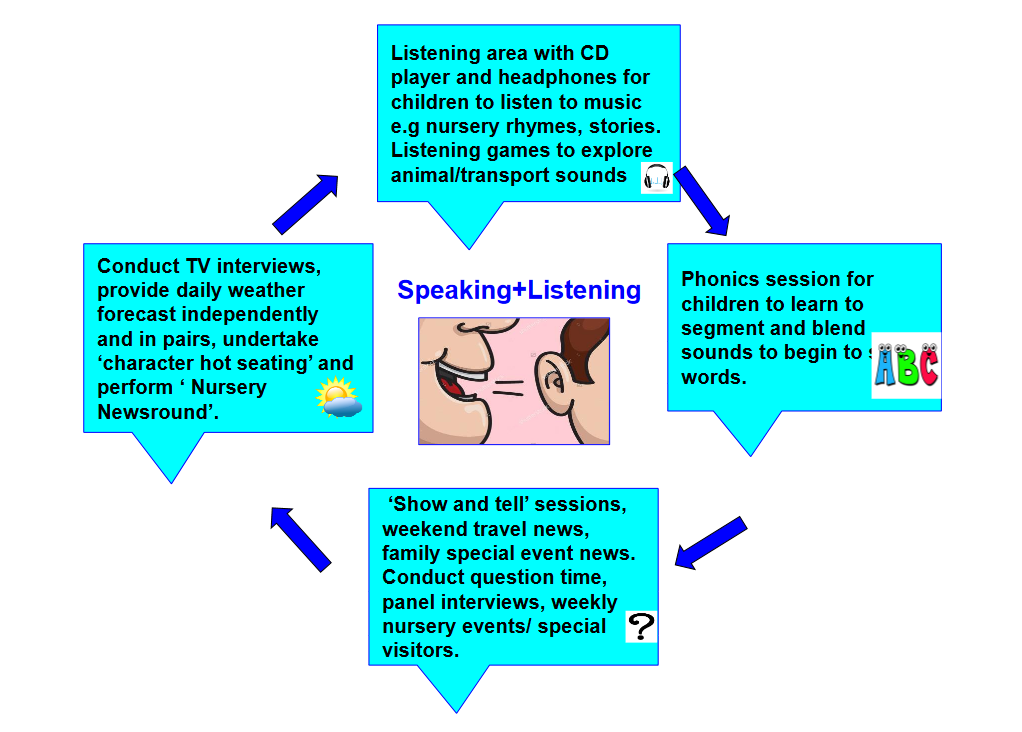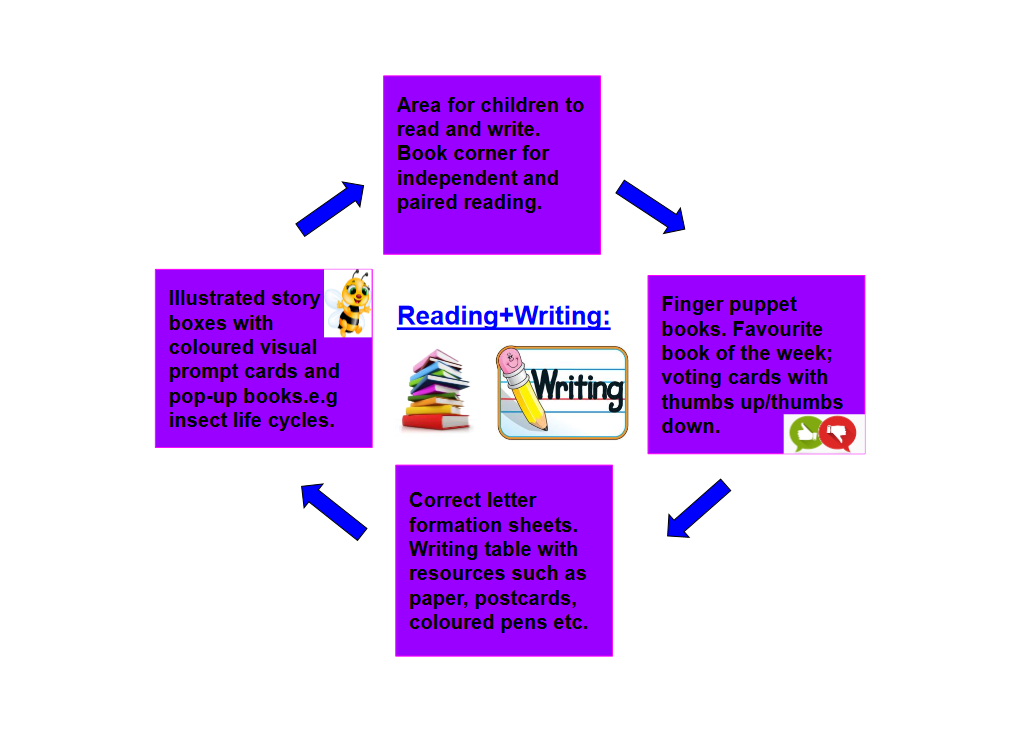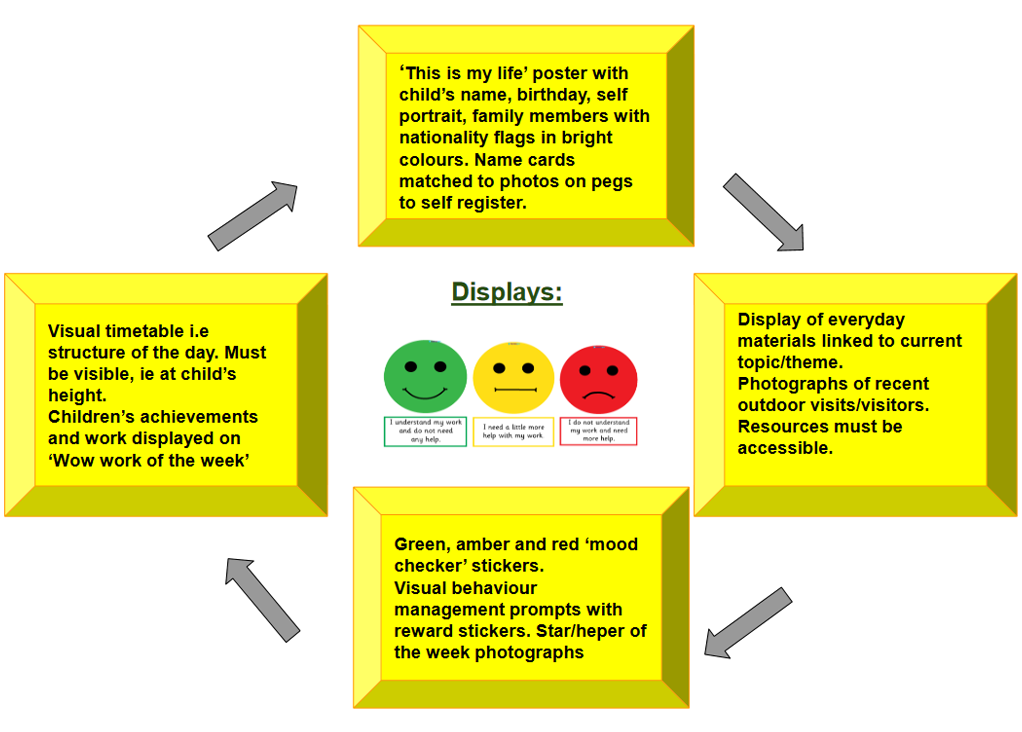Module Two: How do you create a vibrant learning environment?
In this module you will learn about…..
- The key areas of learning that must be covered to ensure children have access to an inspirational learning environment
- Useful ideas about what to include in displays and learning prompts to enhance learning
Three types of planning
- Long term
- Medium term
- Short Term
Long term planning
Long term planning refers to the guidance in the framework for children within the Early Years age range. The
planning structure assists practitioners to ensure full coverage of all areas of learning. It ensures a range of
activities both indoors and outdoors throughout the day.
Website link to Early Years Framework
http://www.foundationyears.org.uk/eyfs-statutory-framework/
Medium Term planning
Medium term planning is a detailed outline of the learning programme between 2-6 weeks. It outlines resources and designated learning areas and outlines plans for observation and assessment.
- It outlines a range of experiences and activities and clarifies daily structures and routines
- Arrival and departures times
- Settling in time
- Provision for indoor and outdoor activities
- Storytimes
- Circle times
- Child initiated and adult directed for quality interaction.
Short term planning
- Short term planning outlines what is provided on a day to day basis. This depends on the children’s needs and is linked to previous learning. It identifies resources and activities that are linked to children’s interests. For example, pet shop, baby clinic (dolls are the patients!)
- It includes comprehensive details such as expected learning outcomes, details of activities to be undertaken, adult deployment and grouping of the children. Examples are meaningful activities such as cooking with the herbs grown by the children as part of the ingredients to make scented pizza! The rest of the ingredients can be bought from the local supermarket. The result of the children’s efforts (i.e. cooked pizza) is served for lunch. Cooking the potatoes children had previously planted is another popular activity!
Designated learning areas
Designated learning areas ensures that children make an informed choice of activities that stimulate their interest. Furthermore, free and easy access to resources builds their confidence and sense of ownership and learning. Learning areas must be vibrant conducive and inspire children to learn
Suggested learning areas:
- Computer technology- finding out about a range of ways that simple technology can aid learning.
- Role play-making use of their imagination in a variety of ways.
- Understanding of the world–undertake investigations, observe properties of insects such as mini beasts and develop knowledge of the life cycle of a butterfly.
- Construction area-Makingthings by themselves, explores professions, building sites and builds towers with bricks.
- Reading Area–exploringbooks and develop an interest and appreciation of texts in a variety of ways.
- Expressive Arts and Design area-creative expression using a range of media.




Reflection questions
- Does the environment encourage curiosity and exploration?
- Does it include creative use of familiar everyday materials and resource such as household objects? (Enlist parents’ help with this)
- Have you effectively used the background information about the children to create a conducive and stimulating environment to support their learning?
- Do activities encourage creativity and open learning experiences to encourage incidental learning?
- Are there opportunities for mark making?
- Does it cater for different styles of learning and provide many practical and sensorial experiences?
- Is there a balance of child initiated and adult directed activities?
- Are resources freely available so that children can access them independently?
Reflection Questions Continued
- Are there visual prompts or key questions that suggest learning or things that children should
learn/attempt to find out? - Is the environment vibrant and conducive to learning to keep children engaged for extended periods of
time? - Is there continuity of learning from the indoor to the outdoor learning environment?
- Is there provision for messy, sensory play such as water, sand, paint, cornflour, with creative use of
contrasting colours which fires children’s imagination? - Are there opportunities for awe and wonder and active promotion of children’s spiritual, moral and social
development? - Are there built in opportunities for children to listen to each other, listen to stories and explore the sounds
of letters? - Are there clearly designated areas of learning so that children can make an informed choice of activities?
- Is there a comfortable and attractive place for children to sit and look at books and read?
- Are there built in practical opportunities for children to explore different ways to solve problems or
overcome obstacles?

